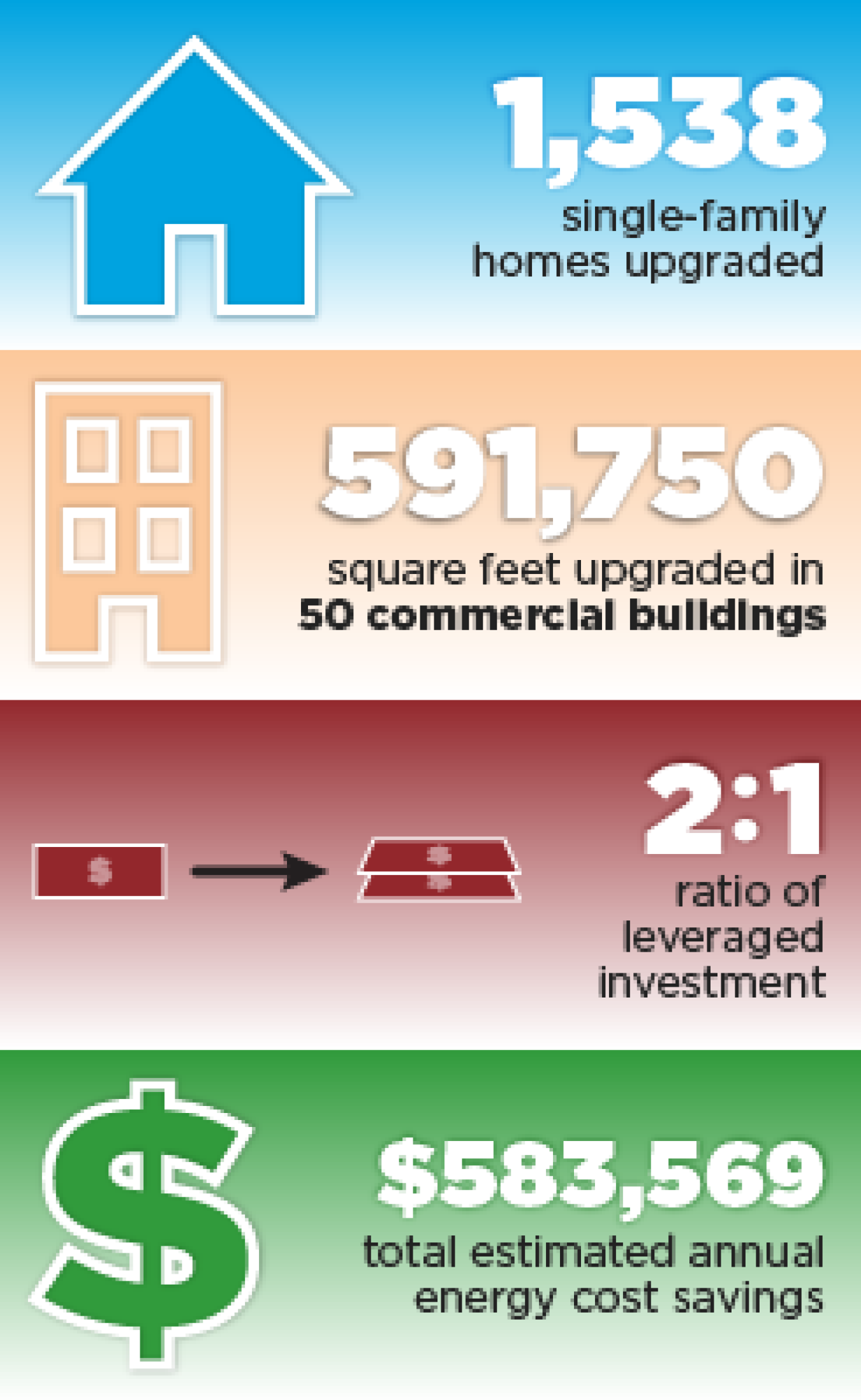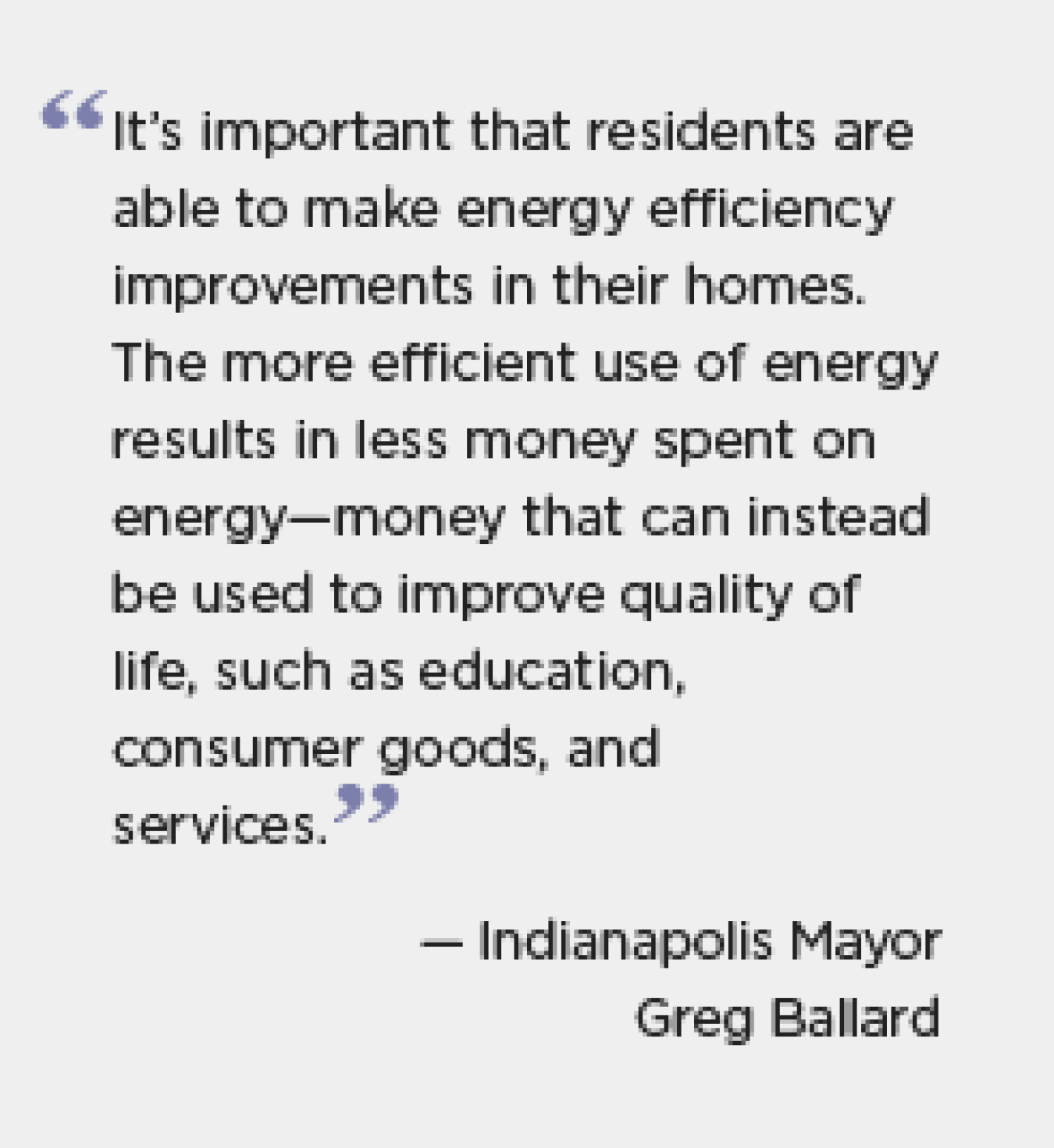
The City of Indianapolis, Indiana, used its status as host of the 2012 Super Bowl to address inefficiencies in the area’s older housing stock and leave behind a legacy of energy efficiency. Seeking to overcome market barriers to residential and commercial energy upgrades and build upon the neighborhood improvement efforts that were part of its Super Bowl Legacy Project, the city created the Indianapolis Better Buildings Program using $10 million in seed funding from the U.S. Department of Energy’s Better Buildings Neighborhood Program.
The Indianapolis Better Buildings Program reached residents, businesses, and non-profit organizations in the city’s Near Eastside neighborhood through an effort known as the Near Eastside Neighborhood Sweeps Program. Additionally, through a sub-grant from the City of Indianapolis, the City of Lafayette, Indiana, created the Lafayette Energy Improvement Program (LEIP) to focus on encouraging residents in two of its neighborhoods to undertake energy-efficiency measures.
Defining Characteristics
Approaches Taken
Key Takeaways
What’s Next?
Additional Resources
DEFINING CHARACTERISTICS
The Indianapolis Better Buildings Program embraced a neighborhood approach to residential and commercial upgrades, focusing on the Near Eastside neighborhood with the “sweeps” approach and two neighborhoods in Lafayette through LEIP. The idea was to target smaller geographic areas and make energy efficiency measures more affordable to program participants, as the cost of labor would be less due to the proximity and possibility for bulk purchasing.
The Sweeps program was designed to reach homeowners in the Near Eastside by utilizing a grassroots outreach strategy. In the Near Eastside and Lafayette neighborhoods, the programs formed partnerships with trusted community organizations, which helped to reach participants and provide them with more information about the benefits of energy efficiency.
ACCOMPLISHMENTS
(July 2010 to June 2014)


Approaches Taken
With both residential and commercial offerings, the Indianapolis Better Buildings Program targeted specific neighborhoods through grassroots outreach to complete energy upgrades.
- Residential Program Design: The program had two residential components: the residential Sweeps program, which targeted Indianapolis’ Near Eastside neighborhood, and LEIP, which focused on the two neighborhoods of Glen Acres and Vinton in Lafayette. Both programs sought to reach a large number of residents in concentrated areas and make energy upgrades more affordable to homeowners. Each program provided energy assessments to residents and offered air sealing, attic insulation, and other direct install measures. After this initial effort, Sweeps participants could receive grants up to $1,500 for upgrades to achieve the targeted minimum of 15% reduction in energy use, after which they were encouraged to take advantage of the EcoHouse Loan Program to finance deeper upgrades. As a quality-control measure, an energy professional also conducted a post-upgrade assessment of each home. LEIP had all the same elements as the residential Sweeps program, with the addition that qualified homeowners were offered grants up to $9,000 to implement upgrades.
- Marketing and Outreach: The residential Sweeps program partnered with trusted neighborhood organizations to serve as energy advocates and to conduct outreach to residents through door-to-door canvassing, community meetings, and educational events. Depending on the neighborhood, the program communicated with residents through local organizations’ newsletters and email listservs, or had early adopters of energy-efficiency measures display yard signs and canvass to encourage their neighbors to participate. LEIP created a demonstration house featuring the latest energy-efficient technologies to demonstrate to residents the benefits of a home energy upgrade.
- Financing: In addition to the grants available to homeowners through the residential Sweeps program and LEIP, the Indianapolis Better Buildings Program partnered with the Indianapolis Neighborhood Housing Project (INHP), a community development financial institution, to offer the EcoHouse Loan Program. This program helped low- to moderate-income households implement deeper energy efficiency measures and was supported by a loan loss reserve. Toward the end of the grant period, the loan loss reserve was converted to a revolving loan fund, supported by a smaller loan loss reserve, to make the program more self-sustaining. The EcoHouse Loan Program offered secured and unsecured low-interest loans to homeowners, in addition to providing free energy assessments. The city also partnered with local utilities to subsidize or completely fund certain energy-efficiency measures for homeowners.
- Workforce Development: The City of Indianapolis partnered with Working 4 Green, a local workforce development non-profit, to select and train individuals in deconstruction, energy efficiency, and other related topics such as weatherization. The program was tailored to the participants’ educational and vocational levels with classroom and field training.
- Commercial Program Design: Starting in March 2013, businesses and nonprofit organizations in the Near Eastside neighborhood could apply and submit data (e.g., square footage, building footprint, etc.) to determine project feasibility and receive a comprehensive energy assessment. A program representative discussed the results with participants and determined how they could achieve at least 15% energy savings by implementing energy upgrades. Eligible customers and projects could receive subsidies of up to $10,000. The program prioritized lighting upgrades and building shell and low-cost heating, ventilation, and air conditioning measures. The program relied on grassroots outreach through neighborhood organizations, as well as earned media, to promote the commercial upgrades and showcased initial pilot upgrades to help recruit more.
Key Takeaways
The Indianapolis Better Buildings Program learned a number of important lessons through the residential sweeps, low-income effort, and commercial program:
- Focus on smaller measures first. The residential sweeps provided homeowners with energy assessments and encouraged them to implement the easier measures first, in order to demonstrate the benefits of energy efficiency, including increased comfort and lower utility bills. The program then directed participants to its EcoHouse Loan Program to help them finance deeper upgrades.
- Increase awareness through demonstration. LEIP’s Near Zero Demonstration Home helped educate residents about energy efficiency and also functioned as a hands-on laboratory for local college students studying building science.
- Utilize trusted neighborhood partners. The residential and commercial programs took advantage of local organizations to help spread the word to homeowners and businesses. The commercial program also used its early adopters to encourage others to participate.
- Check for quality control. After residential sweeps participants implemented upgrades, a post-upgrade blower door test was used to assess the quality of the work being done. This quality control measure enabled the program to detect problems in vendors’ work and ensure quality service to program participants; where necessary, new vendor teams were used to implement energy efficiency measures.
- Conduct pilots to inform commercial program design. The results of the commercial sweeps pilot showed that it would be difficult to achieve 15% energy savings in the commercial sector, so the program changed its design. This included adjusting the program incentives, offering participants $10,000 to complete upgrades instead of the $2,000 offered during the pilot, and prioritizing energy-efficiency measures that businesses could more likely implement.
What's Next?
While the Indianapolis Better Buildings Program’s residential and commercial energy efficiency programs have come to an end, the two loan programs it helped established will continue:
- The City of Indianapolis, in partnership with INHP, will continue to operate the EcoHouse Loan Program through 2019.
- AFC First Financial Corporation will provide loan and credit enhancement administration for two different energy efficiency financing offerings for residents—the National Energy Loan and the FHA PowerSaver Loan. AFC will also collaborate with the City of Indianapolis on training and recruitment of contractors to promote those loan offerings.
- The EcoHouse Loan Program was expected to become an equipment-only program, meaning that it would remove the energy assessment requirement and subsidy, decreasing both the program’s administrative and incentive costs.
Additional Resources
Reports
